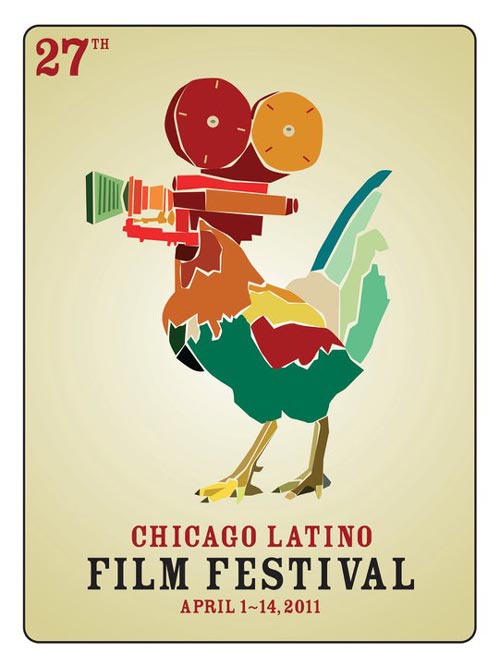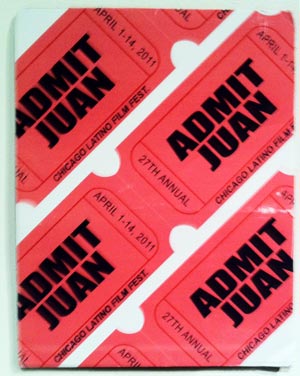La bota…la calavera…el diablo…el gallo! La lotería is an inherently Mexican tradition enjoyed and fondly remembered by so many. When you call yourself a Latino, there are many clichés that often come to mind: the salsa dancing, hot-sauce–eating, luchador-mask–wearing, always late, Aztec/Maya/Inca-deity–loving Latinos. As a Latino artist and art lover, this is one of the greatest blessings and curses—having the ability to use a symbol or an object that can unite an entire culture of people. You can poke fun, exaggerate it and even take it to a whole new level of visual aesthetics.
For 27 years the Chicago Latino Film Festival has created a community of international film lovers. It handpicks some of the best independent, documentary and heart-string–tugging films and brings them to an audience who might otherwise not have seen them. This a very noteworthy mission, but as with any organization, good branding and thoughtful marketing is imperative to its success.
The strength and cohesion of the Chicago Latino community is what makes this festival a success year after year. It is in this spirit that the International Latino Cultural Center holds an open call for poster submissions every year. This encourages the community of artists and designers to get involved and gives them an opportunity to have their work adorn a gallery wall during the contest winner announcement. However, this can also be a slippery slope. The submissions can be of varying calibers and, at times, not allow for much of a choice. You could say the same thing applied to this year, but I do happen to agree with this year’s selections.

The winning poster this year was designed by Claudia Renzi, a Venezuelan graphic designer based in Chicago. The piece has an interesting appeal with the juxtaposition of the gallo and the film camera. If it would have dared to stray away from the card-style border and typographic treatment, it may have been even stronger (design-wise), since once those elements are thrown in, we start to feel the weight of that memorable lotería card. The runner-up was titled “Admit Juan,” and had a great play on words that reminds us of our various run-ins with accents and lost-in-translation moments. While a funny and successful concept, it might not have reached a wider audience the way the gallo does.

So as you can see, the judges who make the final selection have a very difficult task: to choose a design that is not only beautiful, entertaining, and inclusive to all Latino cultures, but also just gets butts in the theater seats.
“It’s difficult to find a design that will work across all medium, from print to billboards and online,” said Carlos Barrera, one of this year’s judges. After speaking to a few of the judges, I was pleased to learn they had a design and/or marketing background. This seems like a smart move on the ILCC’s part, and I encourage them to keep going in this direction.
Every year, we must ask ourselves the same questions about the winning poster: Do I like it? What does it speak about our community as a whole? Is it representative of all backgrounds? Are we a luchador-mask–wearing, Frida Kahlo–loving people? Yes. Yes, we are.
Is this an issue of nationalism or culture, or simply admiration for the intrinsic aesthetic value of art? It’s a delicate balance that a designer must exercise, explore and, at times, stay away from. If not handled properly, this could encourage a sort of Mexican bandido stereotype that for years plagued the film industry. These questions are not intended to call out any one particular poster designer or another. This is to put a call out to artist and designers to be aware of that line and only cross it when appropriate.
“It’s a fine line,” said Karina Diehl, another one of the judges. “If it’s done in a way where we get it and it’s not derogatory, then it works. As long it enhances the culture, then it works.”
As Latino designers, it is our duty to design with a purpose, not just to fill a naive or preconceived notion of a culture. Above all else we must strive for quality. To all my comrades, start working on next year’s submissions now. While a poster design may appear trivial, it has the potential to move our people and culture forward, while honoring the past.
What is your opinions on this year’s poster selection?
I didn’t get the image! Can someone explain me the rooster and being Latino?
All “Latinos” didn’t raise chickens growing up? 😛 I did actually. My great grandfather sent some down when I was 10 and I had to feed them and take care of them. Kinda like a dog, but harder to hug.
I get it. Its supposed to be a loteria cardish? But I’m not certain if I like it 100%.
Yeah, I wondered how many Latinos would relate to it, too. I associate that symbol with machismo (“gallo” as slang for “man,” cock-fighting, etc.). So personally I was a bit put off by it. It’s certainly better than last year’s, though.
To be honest, I like “Admit Juan” a little bit more, visually and play-on-wordingly. And it also reaches to Latinos beyond the overwhelming Mexican majority in the city. As far as I know, loteria cards are mainly a Mexican thing, in the realm of calaveras de azucar and gritos libertadores.
I don’t get it either… why does the rooster have a movie camera head? I associate cock fighting with Filipinos and Hawaiians, and I saw chickens running around in Vietnamese villages. My Japanese great-grandmother had chickens as pets (or were they for eggs?). What do I know, soy una japonesa…
I actually love the rooster.. I understand the fine line, trust me but not every one who raises them has done it for the sole purpose of fighting. Maybe it’s time we elevated the rooster from the stereo typical status and reflected it as something more, a strong and elegant creature. Maybe I’m biased.. I did almost bring one back from my trip to Mexico.. they’re just so cute and if you raise them from hatchlings you can totally hug them!
You are right…you know nada!
La peleas de gallos son tipicamente mexicanas. Por años Mexico señaló el camino del cine………
Un gallo filmando: !!!!Estupendo¡¡¡ Idea, colores, vida y movimiento.
Claudia fuiste simpaticamente estupenda…….y ganaste.
Bob
I’m more curious what the other entries were like. However, I like what you wrote and the importance of breaking w/ cliches. Personally, I’m going to puke the next time I see a folklorico dancer used to advertise/announce anything…even folklorico dance. First of all, it’s very important that the judges have a background in design or marketing. So, keep encouraging them to do so. Otherwise they’ll be inundated with community docent types who offer little more than a smile and a pinche golf clap for everything.
Personally, I was more impressed with your writing and observations. You hit the nail on the head, Abraham!